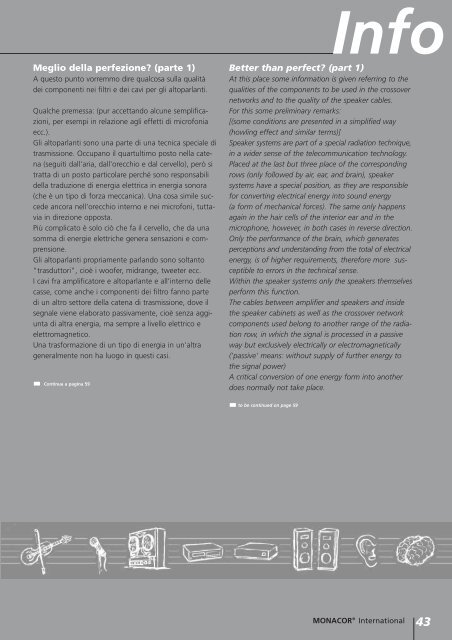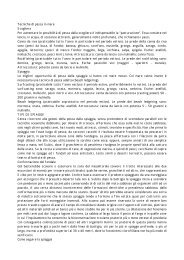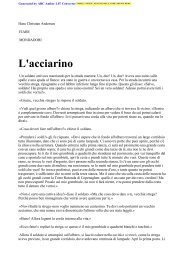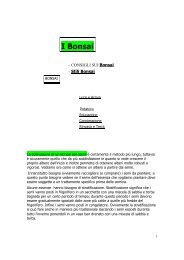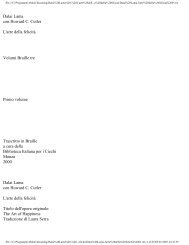Create successful ePaper yourself
Turn your PDF publications into a flip-book with our unique Google optimized e-Paper software.
Meglio della perfezione? (parte 1)<br />
A questo punto vorremmo dire qualcosa sulla qualità<br />
dei componenti nei filtri e dei cavi per gli altoparlanti.<br />
Qualche premessa: (pur accettando alcune semplificazioni,<br />
per esempi in relazione agli effetti di microfonia<br />
ecc.).<br />
Gli altoparlanti sono una parte di una tecnica speciale di<br />
trasmissione. Occupano il quartultimo posto nella catena<br />
(seguiti dall'aria, dall'orecchio e dal cervello), però si<br />
tratta di un posto particolare perché sono responsabili<br />
della traduzione di energia elettrica in energia sonora<br />
(che è un tipo di forza meccanica). Una cosa simile succede<br />
ancora nell'orecchio interno e nei microfoni, tuttavia<br />
in direzione opposta.<br />
Più complicato è solo ciò che fa il cervello, che da una<br />
somma di energie elettriche genera sensazioni e comprensione.<br />
Gli altoparlanti propriamente parlando sono soltanto<br />
"trasduttori", cioè i woofer, midrange, tweeter ecc.<br />
I cavi fra amplificatore e altoparlante e all'interno delle<br />
<strong>casse</strong>, come anche i componenti dei filtro fanno parte<br />
di un altro settore della catena di trasmissione, dove il<br />
segnale viene elaborato passivamente, cioè senza aggiunta<br />
di altra energia, ma sempre a livello elettrico e<br />
elettromagnetico.<br />
Una trasformazione di un tipo di energia in un'altra<br />
generalmente non ha luogo in questi casi.<br />
Continua a pagina 59<br />
Info<br />
Better than perfect? (part 1)<br />
At this place some information is given referring to the<br />
qualities of the components to be used in the crossover<br />
networks and to the quality of the speaker cables.<br />
For this some preliminary remarks:<br />
[(some conditions are presented in a simplified way<br />
(howling effect and similar terms)]<br />
Speaker systems are part of a special radiation technique,<br />
in a wider sense of the telecommunication technology.<br />
Placed at the last but three place of the corresponding<br />
rows (only followed by air, ear, and brain), speaker<br />
systems have a special position, as they are responsible<br />
for converting electrical energy into sound energy<br />
(a form of mechanical forces). The same only happens<br />
again in the hair cells of the interior ear and in the<br />
microphone, however, in both cases in reverse direction.<br />
Only the performance of the brain, which generates<br />
perceptions and understanding from the total of electrical<br />
energy, is of higher requirements, therefore more susceptible<br />
to errors in the technical sense.<br />
Within the speaker systems only the speakers themselves<br />
perform this function.<br />
The cables between amplifier and speakers and inside<br />
the speaker cabinets as well as the crossover network<br />
components used belong to another range of the radiation<br />
row, in which the signal is processed in a passive<br />
way but exclusively electrically or electromagnetically<br />
('passive' means: without supply of further energy to<br />
the signal power)<br />
A critical conversion of one energy form into another<br />
does normally not take place.<br />
to be continued on page 59<br />
MONACOR ® International 43


